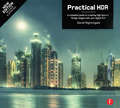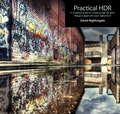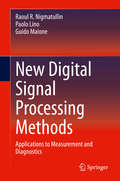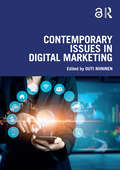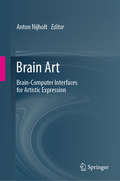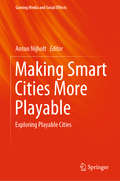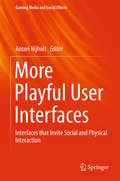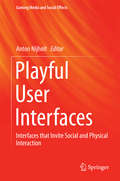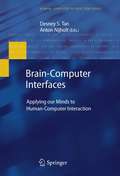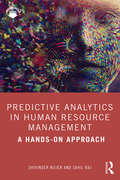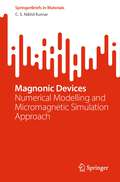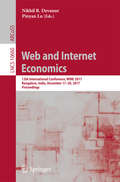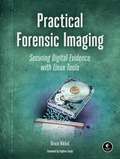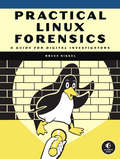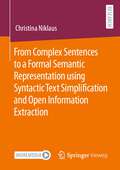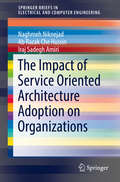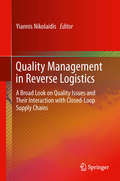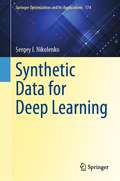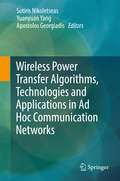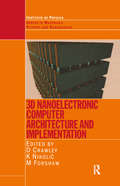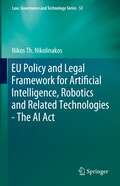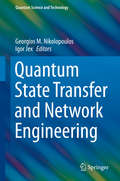- Table View
- List View
Practical HDR: A complete guide to creating High Dynamic Range images with your Digital SLR
by David NightingaleHDR is both a technical solution to the limitations of digital camera sensors, and a creative tool that can give any image much more impact - but it is not without its pitfalls, and it's essential to understand these if you want to take full advantage of this innovative technique. The second edition of David Nightingale's successful Practical HDR is completely updated with the latest techniques and technologies in HDR. Practical HDR provides you with an abundance of step-by-step examples that will quickly make you an expert on the theory and practice of shooting and processing HDR images, allowing you to get the best possible results every time. As well as practical advice on shooting and processing, the book also contains a global showcase of inspirational HDR images - you will quickly find that HDR offers unparralleled opportunities for indulging your creative instincts, from photo-realistic to hyper-realism.
Practical HDR (2nd Edition): The Complete Guide To Creating High Dynamic Range Images With Your Digital Slr
by David NightingaleThe first edition of David Nightingale's Practical HDR swiftly established itself as the standard work on this cutting-edge processing technique, garnering rave reviews and reprinting several times. Now, technical advances in the field have expanded HDR's possibilities still further, and this second, expanded edition, revised throughout, will cement David's reputation as the most respected writer in the field.Covering new programs, in particular Adobe CS5's HDR capabilities, and with more killer photos from the world's leading lights in HDR processing, Practical HDR will let the reader create jaw-dropping images that demand a second look.
New Digital Signal Processing Methods: Applications to Measurement and Diagnostics
by Raoul R. Nigmatullin Paolo Lino Guido MaioneThis book is intended as a manual on modern advanced statistical methods for signal processing. The objectives of signal processing are the analysis, synthesis, and modification of signals measured from different natural phenomena, including engineering applications as well. Often the measured signals are affected by noise, distortion and incompleteness, and this makes it difficult to extract significant signal information. The main topic of the book is the extraction of significant information from measured data, with the aim of reducing the data size while keeping the basic information/knowledge about the peculiarities and properties of the analyzed system; to this aim, advanced and recently developed methods in signal analysis and treatment are introduced and described in depth. More in details, the book covers the following new advanced topics (and the corresponding algorithms), including detailed descriptions and discussions: the Eigen-Coordinates (ECs) method, The statistics of the fractional moments, The quantitative "universal" label (QUL) and the universal distribution function for the relative fluctuations (UDFRF), the generalized Prony spectrum, the Non-orthogonal Amplitude Frequency Analysis of the Smoothed Signals (NAFASS), the discrete geometrical invariants (DGI) serving as the common platform for quantitative comparison of different random functions. Although advanced topics are discussed in signal analysis, each subject is introduced gradually, with the use of only the necessary mathematics, and avoiding unnecessary abstractions. Each chapter presents testing and verification examples on real data for each proposed method. In comparison with other books, here it is adopted a more practical approach with numerous real case studies.
The Unpredictable Certainty: Information Infrastructure Through 2000
by NII 2000 Steering CommitteeWe have available an impressive array of information technology. We can transmit literature, movies, music, and talk. Government, businesses, and individuals are eager to go on-line to buy, sell, teach, learn, and more. How, then, should we go about developing an infrastructure for on- line communication among everyone everywhere? The Unpredictable Certainty explores the national information infrastructure (NII) as the collection of all public and private information services. But how and when will the NII become a reality? How will more and better services reach the home, small businesses, and remote locations? The Unpredictable Certainty examines who will finance the NII, exploring how technology companies decide to invest in deployment and the the vain search for "killer apps" (applications that drive markets). It discusses who will pay for ongoing services and how they will pay, looking at past cost/price models relevant to the future. The Unpredictable Certainty discusses the underlying technologies, appliances, and services needed before the NII becomes a reality; reviews key features of important technologies; and analyzes current levels of deployment in telephone, cable and broadcast television, and wireless systems, and the difficulties in interconnection. The volume explores the challenge of open interfaces that stimulate new applications but also facilitate competition, the trend toward the separation of infrastructure from specific services, the tension between mature services and new contenders, the growth of the Internet, and more. The roles governments at different levels might play in fostering NII deployment are outlined, including R&D and the use of information infrastructure for better delivery of government services and information.
Contemporary Issues in Digital Marketing
by Outi NiininenThis book presents a comprehensive overview of the key topics, best practices, future opportunities and challenges in the Digital Marketing discourse. With contributions from world-renowned experts, the book covers: • Big Data, Artificial Intelligence and Analytics in Digital Marketing • Emerging technologies and how they can enhance User Experience • How ‘digital’ is changing servicescapes • Issues surrounding ethics and privacy • Current and future issues surrounding Social Media • Key considerations for the future of Digital Marketing • Case studies and examples from real-life organisations Unique in its rigorous, research-driven and accessible approach to the subject of Digital Marketing, this text is valuable supplementary reading for advanced undergraduate and postgraduate students studying Digital and Social Media Marketing, Customer Experience Management, Digital Analytics and Digital Transformation.
Brain Art: Brain-Computer Interfaces for Artistic Expression
by Anton NijholtThis is the first book on brain-computer interfaces (BCI) that aims to explain how these BCI interfaces can be used for artistic goals. Devices that measure changes in brain activity in various regions of our brain are available and they make it possible to investigate how brain activity is related to experiencing and creating art. Brain activity can also be monitored in order to find out about the affective state of a performer or bystander and use this knowledge to create or adapt an interactive multi-sensorial (audio, visual, tactile) piece of art. Making use of the measured affective state is just one of the possible ways to use BCI for artistic expression. We can also stimulate brain activity. It can be evoked externally by exposing our brain to external events, whether they are visual, auditory, or tactile. Knowing about the stimuli and the effect on the brain makes it possible to translate such external stimuli to decisions and commands that help to design, implement, or adapt an artistic performance, or interactive installation. Stimulating brain activity can also be done internally. Brain activity can be voluntarily manipulated and changes can be translated into computer commands to realize an artistic vision. The chapters in this book have been written by researchers in human-computer interaction, brain-computer interaction, neuroscience, psychology and social sciences, often in cooperation with artists using BCI in their work. It is the perfect book for those seeking to learn about brain-computer interfaces used for artistic applications.
Making Smart Cities More Playable: Exploring Playable Cities (Gaming Media and Social Effects)
by Anton NijholtThis book explores the ways in which the broad range of technologies that make up the smart city infrastructure can be harnessed to incorporate more playfulness into the day-to-day activities that take place within smart cities, making them not only more efficient but also more enjoyable for the people who live and work within their confines. The book addresses various topics that will be of interest to playable cities stakeholders, including the human–computer interaction and game designer communities, computer scientists researching sensor and actuator technology in public spaces, urban designers, and (hopefully) urban policymakers. This is a follow-up to another book on Playable Cities edited by Anton Nijholt and published in 2017 in the same book series, Gaming Media and Social Effects.
More Playful User Interfaces
by Anton NijholtThis book covers the latest advances in playful user interfaces - interfaces that invite social and physical interaction. These new developments include the use of audio, visual, tactile and physiological sensors to monitor, provide feedback and anticipate the behavior of human users. The decreasing cost of sensor and actuator technology makes it possible to integrate physical behavior information in human-computer interactions. This leads to many new entertainment and game applications that allow or require social and physical interaction in sensor- and actuator-equipped smart environments. The topics discussed include: human-nature interaction, human-animal interaction and the interaction with tangibles that are naturally integrated in our smart environments. Digitally supported remote audience participation in artistic or sport events is also discussed. One important theme that emerges throughout the book is the involvement of users in the digital-entertainment design process or even design and implementation of interactive entertainment by users themselves, including children doing so in educational settings.
Playful User Interfaces
by Anton NijholtThe book is about user interfaces to applications that have been designed for social and physical interaction. The interfaces are 'playful', that is, users feel challenged to engage in social and physical interaction because that will be fun. The topics that will be present in this book are interactive playgrounds, urban games using mobiles, sensor-equipped environments for playing, child-computer interaction, tangible game interfaces, interactive tabletop technology and applications, full-body interaction, exertion games, persuasion, engagement, evaluation and user experience. Readers of the book will not only get a survey of state-of-the-art research in these areas, but the chapters in this book will also provide a vision of the future where playful interfaces will be ubiquitous, that is, present and integrated in home, office, recreational, sports and urban environments, emphasizing that in the future in these environments game elements will be integrated and welcomed.
Playful User Interfaces: Interfaces that Invite Social and Physical Interaction (Gaming Media and Social Effects)
by Anton NijholtThe book is about user interfaces to applications that have been designed for social and physical interaction. The interfaces are ‘playful’, that is, users feel challenged to engage in social and physical interaction because that will be fun. The topics that will be present in this book are interactive playgrounds, urban games using mobiles, sensor-equipped environments for playing, child-computer interaction, tangible game interfaces, interactive tabletop technology and applications, full-body interaction, exertion games, persuasion, engagement, evaluation and user experience. Readers of the book will not only get a survey of state-of-the-art research in these areas, but the chapters in this book will also provide a vision of the future where playful interfaces will be ubiquitous, that is, present and integrated in home, office, recreational, sports and urban environments, emphasizing that in the future in these environments game elements will be integrated and welcomed.
Brain-Computer Interfaces: Applying our Minds to Human-Computer Interaction (Human–Computer Interaction Series)
by Anton Nijholt Desney S. TanFor generations, humans have fantasized about the ability to create devices that can see into a person's mind and thoughts, or to communicate and interact with machines through thought alone. Such ideas have long captured the imagination of humankind in the form of ancient myths and modern science fiction stories. Recent advances in cognitive neuroscience and brain imaging technologies have started to turn these myths into a reality, and are providing us with the ability to interface directly with the human brain. This ability is made possible through the use of sensors that monitor physical processes within the brain which correspond with certain forms of thought. Brain-Computer Interfaces: Applying our Minds to Human-Computer Interaction broadly surveys research in the Brain-Computer Interface domain. More specifically, each chapter articulates some of the challenges and opportunities for using brain sensing in Human-Computer Interaction work, as well as applying Human-Computer Interaction solutions to brain sensing work. For researchers with little or no expertise in neuroscience or brain sensing, the book provides background information to equip them to not only appreciate the state-of-the-art, but also ideally to engage in novel research. For expert Brain-Computer Interface researchers, the book introduces ideas that can help in the quest to interpret intentional brain control and develop the ultimate input device. It challenges researchers to further explore passive brain sensing to evaluate interfaces and feed into adaptive computing systems. Most importantly, the book will connect multiple communities allowing research to leverage their work and expertise and blaze into the future.
Predictive Analytics in Human Resource Management: A Hands-on Approach
by Shivinder Nijjer Sahil RajThis volume is a step-by-step guide to implementing predictive data analytics in human resource management (HRM). It demonstrates how to apply and predict various HR outcomes which have an organisational impact, to aid in strategising and better decision-making. The book: Presents key concepts and expands on the need and role of HR analytics in business management. Utilises popular analytical tools like artificial neural networks (ANNs) and K-nearest neighbour (KNN) to provide practical demonstrations through R scripts for predicting turnover and applicant screening. Discusses real-world corporate examples and employee data collected first-hand by the authors. Includes individual chapter exercises and case studies for students and teachers. Comprehensive and accessible, this guide will be useful for students, teachers, and researchers of data analytics, Big Data, human resource management, statistics, and economics. It will also be of interest to readers interested in learning more about statistics or programming.
Magnonic Devices: Numerical Modelling and Micromagnetic Simulation Approach (SpringerBriefs in Materials)
by C. S. Nikhil KumarThis book briefly looks at numerical modeling and micromagnetic simulation results of magnonic crystals, which are periodically modulated magnonic devices regarded as the magnetic counterpart of photonic crystals with spin waves acting as the information carrier. Since the wavelength of the spin wave is several orders of magnitude shorter than that of electromagnetic waves of the same frequency, magnonic crystals are promising candidates for miniaturization, especially in the fields of data storage and processing. The book begins by describing the dispersion relation of dipolar spin waves in a magnonic curved waveguide, solving Walker's equation in cylindrical coordinates, and then calculating the dispersion of exchange spin waves using perturbation theory. It describes simulated nano-contact-driven spin wave excitations in a magnonic cavity, featuring a design of an antidot magnonic crystal around the nano-contact, with the frequency of the spin wave mode generated lying within the band gap of the magnonic crystal. The proposed device behaves as a SWASER—Spin Wave Amplification by the Stimulated Emission of Radiation. This book will find interest among researchers and practitioners interested in the modeling, simulation, and design of novel magnonic devices.
Web and Internet Economics: 13th International Conference, WINE 2017, Bangalore, India, December 17–20, 2017, Proceedings (Lecture Notes in Computer Science #10660)
by Nikhil R. Devanur and Pinyan LuThis book constitutes the thoroughly refereed proceedings of the 13th International Conference on Web and Internet Economics, WINE 2017, held in Bangalore, India, in December 2017. The 28 full and 6 short papers presented were carefully reviewed and selected from 89 submissions. The papers reflect the work of researchers in theoretical computer science, artificial intelligence, and microeconomics who have joined forces to tackle problems at the intersection of computation, game theory and economics.
Create Stunning Renders Using V-Ray in 3ds Max: Guiding the Next Generation of 3D Renderers
by Margarita NikitaCreate Stunning Renders using V-Ray in 3ds Max: Guiding the Next Generation of 3D Renderers is a step-by-step guide on how to create realistic renderings using V-Ray in 3ds Max. The potentials of V-Ray are detailed using a bedroom scene as an example. The book introduces the 3ds Max interface and the basic commands, allowing readers to familiarize themselves with the work environment from the very beginning. This book is intended for architects, interior designers, and anyone else wanting to create photorealistic renderings using V-Ray in 3ds Max. The reader does not need experience to follow this book, but any prior knowledge of working in 3ds Max will help the reader jump right in. Margarita Nikita is the co-founder of High Q Renders LLC, an award-winning creative company based in San Francisco, CA, with offices in Greece. Nikita has published several design books on 2D and 3D graphic design, some of which are used in university courses, actively contributing to the formation of the new generation of 3D modelers in her native country, Greece. She shares her knowledge, advice, and tips and tricks on her YouTube channel, Margarita Nikita. More of her work is available at her Instagram account, @margarita.nikita.
Practical Forensic Imaging: Securing Digital Evidence with Linux Tools
by Bruce NikkelForensic image acquisition is an important part of postmortem incident response and evidence collection. Digital forensic investigators acquire, preserve, and manage digital evidence to support civil and criminal cases; examine organizational policy violations; resolve disputes; and analyze cyber attacks.Practical Forensic Imaging takes a detailed look at how to secure and manage digital evidence using Linux-based command line tools. This essential guide walks you through the entire forensic acquisition process and covers a wide range of practical scenarios and situations related to the imaging of storage media.You’ll learn how to:–Perform forensic imaging of magnetic hard disks, SSDs and flash drives, optical discs, magnetic tapes, and legacy technologies–Protect attached evidence media from accidental modification–Manage large forensic image files, storage capacity, image format conversion, compression, splitting, duplication, secure transfer and storage, and secure disposal–Preserve and verify evidence integrity with cryptographic and piecewise hashing, public key signatures, and RFC-3161 timestamping–Work with newer drive and interface technologies like NVME, SATA Express, 4K-native sector drives, SSHDs, SAS, UASP/USB3x, and Thunderbolt–Manage drive security such as ATA passwords; encrypted thumb drives; Opal self-encrypting drives; OS-encrypted drives using BitLocker, FileVault, and TrueCrypt; and others–Acquire usable images from more complex or challenging situations such as RAID systems, virtual machine images, and damaged mediaWith its unique focus on digital forensic acquisition and evidence preservation, Practical Forensic Imaging is a valuable resource for experienced digital forensic investigators wanting to advance their Linux skills and experienced Linux administrators wanting to learn digital forensics. This is a must-have reference for every digital forensics lab.
Practical Linux Forensics: A Guide for Digital Investigators
by Bruce NikkelA resource to help forensic investigators locate, analyze, and understand digital evidence found on modern Linux systems after a crime, security incident or cyber attack.Practical Linux Forensics dives into the technical details of analyzing postmortem forensic images of Linux systems which have been misused, abused, or the target of malicious attacks. It helps forensic investigators locate and analyze digital evidence found on Linux desktops, servers, and IoT devices. Throughout the book, you learn how to identify digital artifacts which may be of interest to an investigation, draw logical conclusions, and reconstruct past activity from incidents. You&’ll learn how Linux works from a digital forensics and investigation perspective, and how to interpret evidence from Linux environments. The techniques shown are intended to be independent of the forensic analysis platforms and tools used.Learn how to: • Extract evidence from storage devices and analyze partition tables, volume managers, popular Linux filesystems (Ext4, Btrfs, and Xfs), and encryption • Investigate evidence from Linux logs, including traditional syslog, the systemd journal, kernel and audit logs, and logs from daemons and applications • Reconstruct the Linux startup process, from boot loaders (UEFI and Grub) and kernel initialization, to systemd unit files and targets leading up to a graphical login • Perform analysis of power, temperature, and the physical environment of a Linux machine, and find evidence of sleep, hibernation, shutdowns, reboots, and crashes • Examine installed software, including distro installers, package formats, and package management systems from Debian, Fedora, SUSE, Arch, and other distros • Perform analysis of time and Locale settings, internationalization including language and keyboard settings, and geolocation on a Linux system • Reconstruct user login sessions (shell, X11 and Wayland), desktops (Gnome, KDE, and others) and analyze keyrings, wallets, trash cans, clipboards, thumbnails, recent files and other desktop artifacts • Analyze network configuration, including interfaces, addresses, network managers, DNS, wireless artifacts (Wi-Fi, Bluetooth, WWAN), VPNs (including WireGuard), firewalls, and proxy settings • Identify traces of attached peripheral devices (PCI, USB, Thunderbolt, Bluetooth) including external storage, cameras, and mobiles, and reconstruct printing and scanning activity
From Complex Sentences to a Formal Semantic Representation using Syntactic Text Simplification and Open Information Extraction
by Christina NiklausThis work presents a discourse-aware Text Simplification approach that splits and rephrases complex English sentences within the semantic context in which they occur. Based on a linguistically grounded transformation stage, complex sentences are transformed into shorter utterances with a simple canonical structure that can be easily analyzed by downstream applications. To avoid breaking down the input into a disjointed sequence of statements that is difficult to interpret, the author incorporates the semantic context between the split propositions in the form of hierarchical structures and semantic relationships, thus generating a novel representation of complex assertions that puts a semantic layer on top of the simplified sentences. In a second step, she leverages the semantic hierarchy of minimal propositions to improve the performance of Open IE frameworks. She shows that such systems benefit in two dimensions. First, the canonical structure of the simplified sentences facilitates the extraction of relational tuples, leading to an improved precision and recall of the extracted relations. Second, the semantic hierarchy can be leveraged to enrich the output of existing Open IE approaches with additional meta-information, resulting in a novel lightweight semantic representation for complex text data in the form of normalized and context-preserving relational tuples.
The Impact of Service Oriented Architecture Adoption on Organizations (SpringerBriefs in Electrical and Computer Engineering)
by Naghmeh Niknejad Ab Razak Hussin Iraj Sadegh AmiriThis book describes Service-Oriented Architecture (SOA) and the significant factors which affect its adoption, such as governance, strategy, complexity, Return on Investment (ROI), business and IT alignment, culture and communication, costs, and security. The study on which this book is based, involved a quantitative analysis to investigate the influential factors for adopting SOA, paving the way to further research in the field.
Quality Management in Reverse Logistics
by Yiannis NikolaidisQuality Management in Reverse Logistics intends to develop, collect, examine and evaluate a number of quality management (QM) tools and techniques, which can be applied in practice in order to understand, review and improve any closed-loop supply chain process. In other words, the book aims to examine the existing relationship between various well-developed and thoroughly studied quality issues, such as QM, quality assurance, standardization of processes and statistical quality control and the emerging research area of reverse logistics. Quality Management in Reverse Logistics contains modeling and quantitative methods that could be used by practitioners and academics in the reverse logistics industry, as well as a thorough description of QM tools and techniques. The book leads the potential reader to broaden their scope of thinking and acting in the new, promising area of reverse logistics, where QM can be applied.
Synthetic Data for Deep Learning (Springer Optimization and Its Applications #174)
by Sergey I. NikolenkoThis is the first book on synthetic data for deep learning, and its breadth of coverage may render this book as the default reference on synthetic data for years to come. The book can also serve as an introduction to several other important subfields of machine learning that are seldom touched upon in other books. Machine learning as a discipline would not be possible without the inner workings of optimization at hand. The book includes the necessary sinews of optimization though the crux of the discussion centers on the increasingly popular tool for training deep learning models, namely synthetic data. It is expected that the field of synthetic data will undergo exponential growth in the near future. This book serves as a comprehensive survey of the field. In the simplest case, synthetic data refers to computer-generated graphics used to train computer vision models. There are many more facets of synthetic data to consider. In the section on basic computer vision, the book discusses fundamental computer vision problems, both low-level (e.g., optical flow estimation) and high-level (e.g., object detection and semantic segmentation), synthetic environments and datasets for outdoor and urban scenes (autonomous driving), indoor scenes (indoor navigation), aerial navigation, and simulation environments for robotics. Additionally, it touches upon applications of synthetic data outside computer vision (in neural programming, bioinformatics, NLP, and more). It also surveys the work on improving synthetic data development and alternative ways to produce it such as GANs. The book introduces and reviews several different approaches to synthetic data in various domains of machine learning, most notably the following fields: domain adaptation for making synthetic data more realistic and/or adapting the models to be trained on synthetic data and differential privacy for generating synthetic data with privacy guarantees. This discussion is accompanied by an introduction into generative adversarial networks (GAN) and an introduction to differential privacy.
Wireless Power Transfer Algorithms, Technologies and Applications in Ad Hoc Communication Networks
by Sotiris Nikoletseas Yuanyuan Yang Apostolos GeorgiadisThis book is the first systematic exposition on the emerging domain of wireless power transfer in ad hoc communication networks. It selectively spans a coherent, large spectrum of fundamental aspects of wireless power transfer, such as mobility management in the network, combined wireless power and information transfer, energy flow among network devices, joint activities with wireless power transfer (routing, data gathering and solar energy harvesting), and safety provisioning through electromagnetic radiation control, as well as fundamental and novel circuits and technologies enabling the wide application of wireless powering. Comprising a total of 27 chapters, contributed by leading experts, the content is organized into six thematic sections: technologies, communication, mobility, energy flow, joint operations, and electromagnetic radiation awareness. It will be valuable for researchers, engineers, educators, and students, and it may also be used as a supplement to academic courses on algorithmic applications, wireless protocols, distributed computing, and networking.
3D Nanoelectronic Computer Architecture and Implementation (Series in Material Science and Engineering)
by K. Nikolic M. Forshaw David CrawleyIt is becoming increasingly clear that the two-dimensional layout of devices on computer chips hinders the development of high-performance computer systems. Three-dimensional structures will be needed to provide the performance required to implement computationally intensive tasks. 3-D Nanoelectronic Computer Architecture and Implementation reviews the state of the art in nanoelectronic device design and fabrication and discusses the architectural aspects of 3-D designs, including the possible use of molecular wiring and carbon nanotube interconnections. This is a valuable reference for those involved in the design and development of nanoelectronic devices and technology.
EU Policy and Legal Framework for Artificial Intelligence, Robotics and Related Technologies - The AI Act (Law, Governance and Technology Series #53)
by Nikos Th. NikolinakosArtificial Intelligence (AI) can benefit our society and economy, but also brings with it new challenges and raises legal and ethical questions. According to the author of this comprehensive analysis, it is imperative to ensure that AI is developed and applied in an appropriate legal and regulatory framework that promotes innovation and investment and, at the same time, addresses the risks associated with certain uses of AI-related technologies.Essential to understanding the relationship between policy and law, this book traces the evolution of EU policy on artificial intelligence and robotics, focusing in particular on the EU’s ethical framework for AI, which defines trust as a prerequisite for ensuring a human-centric approach.The main part of the book provides a thorough and systematic analysis of the Commission’s 2021 proposed AI Act, which establishes harmonised rules for the development, placement on the market and use of AI systems in the EU. The author painstakingly compares the Commission’s proposed AI Act with the numerous “compromise” proposals of the Council of the European Union, leading to the final version of the Council’s AI Act (general approach) and its formal adoption on 6 December 2022. The author also examines with extraordinary detail the amendments proposed by the relevant committees and political groups of the European Parliament, revealing the position the Parliament is likely to adopt in the forthcoming negotiations with the Commission and the Council on the text of the AI Act.Numerous legislative and policy documents are presented in detail, while the analysis also considers the comments made by all interested parties (e.g. the European Commission, Council of the European Union, European Parliament, governmental organisations, national competent authorities, and stakeholders/actors with different/conflicting interests, such as corporations, business and consumer associations, civil society and other non-profit organisations). In the course of its in-depth analysis, this book will provide readers with crucial insight into the reasons behind the European Institutions’ different approaches and the often contradictory interests of stakeholders. Because the policy arguments are carefully balanced and drafted with scrupulous care, this volume will establish itself as a reference resource to be consulted for years to come.
Quantum State Transfer and Network Engineering
by Georgios M. Nikolopoulos Igor JexFaithful communication is a necessary precondition for large-scale quantum information processing and networking, irrespective of the physical platform. Thus, the problems of quantum-state transfer and quantum-network engineering have attracted enormous interest over the last years, and constitute one of the most active areas of research in quantum information processing. The present volume introduces the reader to fundamental concepts and various aspects of this exciting research area, including links to other related areas and problems. The implementation of state-transfer schemes and the engineering of quantum networks are discussed in the framework of various quantum optical and condensed matter systems, emphasizing the interdisciplinary character of the research area. Each chapter is a review of theoretical or experimental achievements on a particular topic, written by leading scientists in the field. The volume aims at both newcomers as well as experienced researchers.
